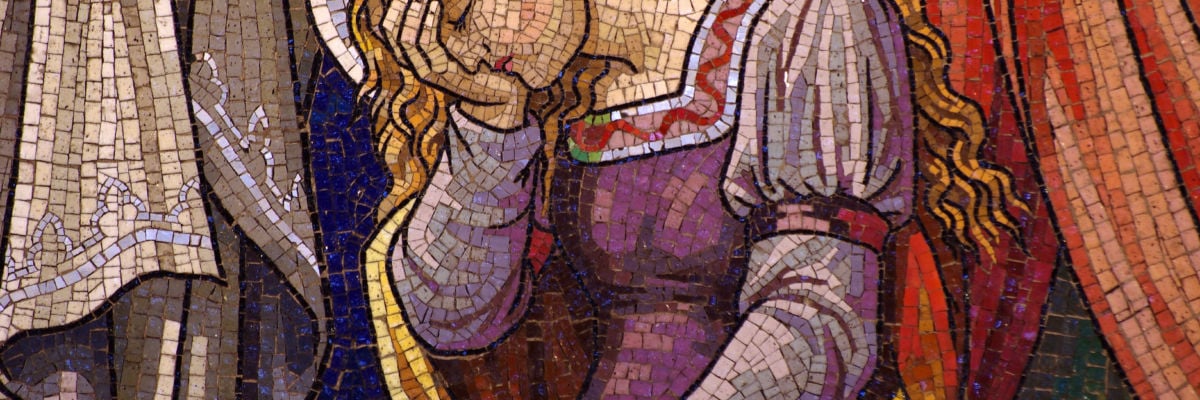
All four Gospels refer to a woman named Mary Magdalene. She is one of the witnesses of Christ’s crucifixion, burial, and resurrection, and she is often named first in lists of women.
All this makes it clear that she was prominent in the early Christian community and was well-known by the authors of the Gospels. But who was she? What do we know about her? And how has her image changed over time?
The first thing to note is her name: Mary Magdalene. Magdalene is not a last name. They didn’t have last names in first-century Jewish society, so what does this term mean?
It helps if you look at the Greek behind it. In Matthew, Mark, and John, she is referred to as Maria hê Magdalênê or Mariam hê Magdalênê. These would be literally translated as “Mary the Magdalene”—so a Magdalene is a kind of person.
The specific kind of person a Magdalene represents is someone from the fishing village of Magdala, which was a mostly Gentile town of about 40,000 people on the western side of the Sea of Galilee.
So Mary was from Magdala in Galilee. She is thus being referred to by a naming convention whereby you give the person’s name and place of origin—as in “Jesus of Nazareth” (Acts 10:38) or “Jesus the Nazarene” (Matt. 26:71).
This place designation is not the most common way that women were referred to in first-century Palestinian Jewish culture. Men were often referred to using a patronym—that is, their father’s name—as in “Simon son of Jonah” (Matt. 16:17) or “Simon son of John” (John 1:42). Women were normally named based on their relatives. However, when an Israelite woman got married, she left the house of her father and became a member of her husband’s household. Consequently, women were commonly referred to in different ways:
- An unmarried woman would be referred to using her father’s name—e.g., “Anna the daughter of Phanuel” (Luke 2:36).
- A married woman would be referred to using her husband’s name—e.g., “Joanna the wife of Chuza” (Luke 8:3).
- A woman who was a mother might be referred to using the name of her son or sons—e.g., “Mary the mother of Jesus” (Acts 1:14), “Mary the mother of James and Joseph” (Matt. 27:56). This would happen especially if the woman was a widow and no longer had a husband.
- And if a woman didn’t have a living father, husband, or son, she might be referred to by the name of her siblings—e.g., though the Gospels never do this, you could refer to “Mary the sister of Martha and Lazarus.”
But none of these things happens for Mary Magdalene. Instead of specifying which Mary we’re talking about by referring to her relatives, she gets a place designation.
This suggests that she didn’t have any relatives who were well known in the early Christian community, so they defaulted back to a place name.
Most likely, she had no father, husband, or sons—and she certainly didn’t have any who were well known.
The identifying thing that stuck out in the minds of the first Christian communities was that she was a Galilean from Magdala, so that’s how they referred to her.
Luke tells us two interesting things about Mary Magdalene. At one point, he says,
Soon afterward [Jesus] went on through cities and villages, preaching and bringing the good news of the kingdom of God. And the Twelve were with him, and also some women who had been healed of evil spirits and infirmities: Mary, called Magdalene, from whom seven demons had gone out, and Joanna, the wife of Chuza, Herod’s steward, and Susanna, and many others, who provided for them out of their means (8:1-3).
This tells us that “seven demons had gone out” of Mary, so she was a former demoniac, and given the context, it was likely Jesus who cast the demons out of her, something that is explicitly stated in the longer ending of Mark (Mark 16:9).
She is also grouped among the women who provided for Jesus and the Twelve “out of their means.” This suggests that Mary was a woman of means. She had money—i.e., disposable income that she could use to support Jesus and his mission.
All four Gospels indicate that Mary was a key witness to the events of the climax of Jesus’ ministry.
She had come with his traveling party to his final Passover in Jerusalem (Matt. 27:55, Mark 15:41), and there she witnessed the Crucifixion (Matt. 27:56, Mark 15:40, John 19:25).
She also witnessed his burial (Matt. 27:61, Mark 16:47) and his resurrection (Matt. 28:1, Mark 16:1, John 20:1), after which she returned and told the Twelve (Luke 24:10, John 20:18).
Luke mentions that the women had prepared spices with which to anoint Jesus’ body on Good Friday, after the Crucifixion (Luke 23:56), and then they brought the spices to the tomb on Easter Monday (24:1). Mark adds the detail that they had bought the spices (Mark 16:1), which would again suggest that Mary Magdalene had financial resources.
But when they arrived at the tomb, they discovered it empty, and angels appeared to them and announced that Jesus has been raised.
John records a touching story of Jesus appearing to Mary Magdalene (John 20:11-18). He doesn’t mention other women being with her, so it is possible she was alone.
When she realizes that she is seeing Jesus, she is overjoyed, but he gives her a warning. Some translations render it, “Do not touch me, for I have not yet ascended to the Father.” This translation is confusing since—before the Ascension happens—Jesus invites Thomas to touch his wounds (John 20:27).
Better translations would be “Do not hold me” (RSV), “Stop holding on to me” (NAB:RE), and “Do not cling to me” (ESV). The idea is that Mary shouldn’t become overly attached to Jesus now that he’s back, because he’s going to be ascending to the Father, and she will not always be able to be with him.
We’ve covered the passages in the New Testament that explicitly name Mary Magdalene, but some Christians have wondered if she may be mentioned in other passages—either with the name Mary or without it.
For example, it has been speculated that she may be the sinful woman (likely a prostitute) who weeps on Jesus’ feet, wipes them with her hair, and anoints his feet (Luke 7:36-50).
The answer is that she almost certainly is not this woman. Not only does Luke not name her, but he also relates this story at the end of chapter 7 of his Gospel. The very next thing he says is the passage quoted above, where Mary Magdalene is introduced.
It is scarcely likely that Luke would omit the woman’s identity at the end of chapter 7 and then immediately introduce her by name at the beginning of chapter 8. We thus have no basis for besmirching Mary Magdalene’s reputation by accusing her of being a prostitute.
Many have identified Mary Magdalene with Mary the sister of Martha and Lazarus, including Pope Gregory I (590-604). However, this also is a mistake.
One reason is that Mary Magdalene is identified as “the Magdalene” in all four Gospels, whereas the two Gospels that refer to the sister of Martha and Lazarus (i.e., Luke and John) identify her with respect to her siblings. This means that the latter Mary had prominent siblings who were known in the Christian community, whereas Mary Magdalene did not.
Further, Mary the sister of Martha and Lazarus isn’t from Magdala. She isn’t even from Galilee. John tells us, “A certain man was sick, Lazarus from Bethany, the village of Mary and her sister Martha” (John 11:1).
Bethany is just outside Jerusalem in Judea, so Mary, Martha, and Lazarus were Judeans rather than Galileans, and Mary of Bethany would have had no need to follow Jesus from Galilee to Jerusalem for the final Passover, because she lived right there!
The idea that Mary Magdalene and Mary of Bethany were the same person was common for a long time in the Western church (not the Eastern churches), and this left a mark on the Western liturgical calendar.
Mary Magdalene has long had a memorial on July 22, whereas Martha has one on July 29. But now that the confusion between Mary Magdalene and Mary of Bethany has been cleared up, the Congregation for Divine Worship ordered in 2021 that the July 29 memorial be listed as that of “Martha, Mary, and Lazarus”—giving the other two Bethany siblings their due on the calendar.



